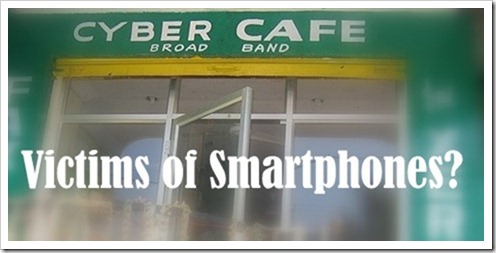I recently wrote an article about how Indians have skipped the wired internet to go the wireless route thanks to easy availability and good tariffs of mobile internet. Arun rightly pointed out that when such an enormous shift occurs there is more than one victim. Collateral damage, if I may say.
When internet came to India, it was basically BSNL that was handing out the broadband and very few people had it. Computers too were not the cheap affair that they are now. Thus, rise of a new service occurred to fulfill the need of the people.
It was Cyber Cafes!
These were points where people use to go to surf the internet and good speeds (broadband) were present in such places. People who were new to computers found this as haven as the person who owned the place knew at least more than them and they could fiddle with the system while exploring the wondrous world of web (www). Along with Cyber cafes rose Orkut, a service that connected people and thus was a boon for school and college going students.
A person could easily see the young crowd filling up the cyber cafes. The prices of computers were going down and so were the prices of broadband.
Cyber cafes started providing add-on services (like flight and ticket booking) and results that are published online.
All this though is coming to moot with mobile phones and specifically smart phones. How?
First, the internet on a smartphone is always on. Be it GPRS or 3G, if the pack is good enough, a person does not have to worry about spending any extra money. In that regards they have become similar to broadband.
Also, the price of an hour in a Cyber Cafe is around Rs. 10 (at least, maybe more). Where as a GPRS pack is less than 100 a month and 3G is less than 1000 a month. This means that while in a cyber cafe a person spends 3 hours a day, he will spend nearly equal to an all day on 3G connection.
Besides, these phones have the option of wifi and USB tethering. Due to this, a person can connect his or her laptop/computer with the phone and surf the internet. Also, facebook, twitter, gmail, nimbuzz all these services are present in a mobile phone (even a feature phone) thereby reducing the need to go to a cyber cafe on a regular basis. Additionally, Government has come down heavily on Cyber Café’s due to unscrupulous activities which take place at such places. They now have to keep details of all the people coming to cyber café’s making it difficult for them to manage.
I have found that the only uses left of a cyber cafe are getting printouts (if need be). This need was still larger until mobile message was not accepted by Indian Rail.
So, comes the point. Who might use the internet in cyber cafes now?
I can think of only few types of people. Students who still do not have internet on their mobile, elderly who live alone and prefer to not use the internet to book ticket themselves and do not have anyone else to rely on as well and maybe to get print outs of projects by anyone.
The problem is that these people might bring some revenue for some cyber cafes but in all, this means the end of road for cyber cafes.
Cyber Cafe’s had their boom time but now there are not enough people using it (and the number is further decreasing fast). The shutters are falling down on cyber cafes. I myself have seen a few closing down in my own locality. Once a force and door to the web for Indians, cyber cafes are seeing their waning days not unlike the social network that was the most visited site in these cyber cafes.
The post Cyber Cafes: Yet another victim of Smartphones? appeared first on India Business & Technology Hub.

No comments:
Post a Comment